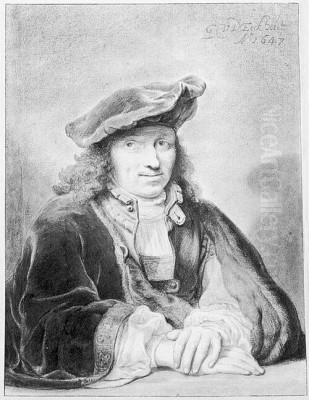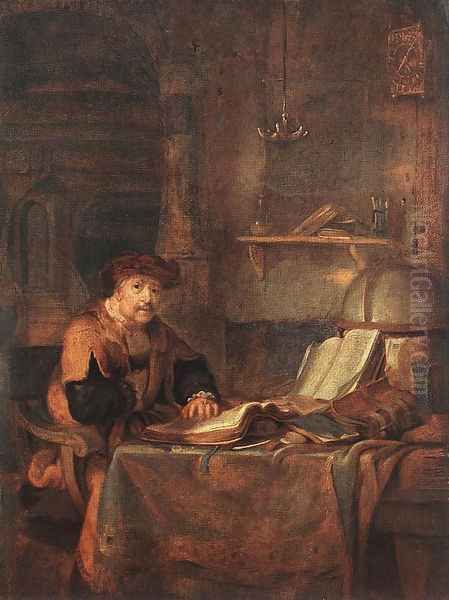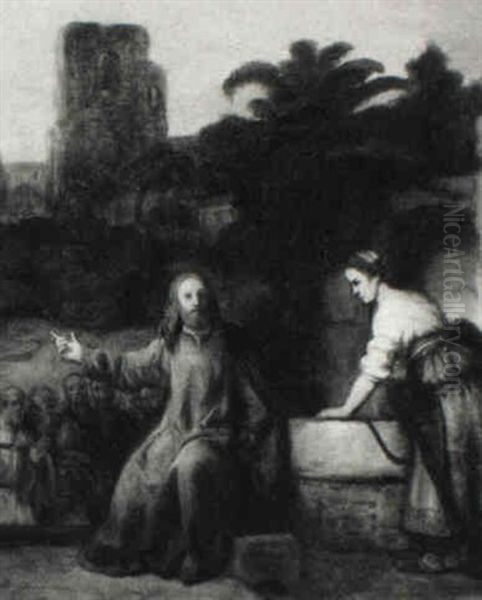
Gerbrand van den Eeckhout stands as a significant figure in the rich tapestry of the Dutch Golden Age of painting. Born in Amsterdam on August 19, 1621, he navigated the vibrant artistic world of the 17th century, leaving behind a legacy marked by skill, versatility, and a deep connection to one of art history's most towering figures, Rembrandt van Rijn. His life, spanning just over five decades until his death in Amsterdam on September 22, 1674, was dedicated to the pursuit of art in its various forms, establishing him as a respected painter, etcher, and connoisseur.
Early Life and Artistic Formation
Gerbrand van den Eeckhout was born into a family with artisanal roots. His father, Jan Pieterszoon van den Eeckhout, was a goldsmith, suggesting an environment where craftsmanship and design were valued. His mother was Grietje Claesdr Lydeker, who sadly passed away in 1631 when Gerbrand was still a child. This early exposure to skilled craft may have influenced his later meticulousness and appreciation for detail.
The most pivotal moment in Eeckhout's artistic development came during his formative years. Sometime between 1635 and the early 1640s, likely concluding around 1640 or 1641, he entered the bustling studio of Rembrandt Harmenszoon van Rijn. This period, lasting approximately five years, placed him at the heart of artistic innovation in Amsterdam. Rembrandt's studio was a crucible of talent, and Eeckhout trained alongside other notable artists who would also make their mark, including Ferdinand Bol, Govert Flinck, and Nicolaes Maes.
Under Rembrandt's tutelage, Eeckhout absorbed the master's techniques and artistic philosophy. He became particularly adept at employing chiaroscuro, the dramatic interplay of light and shadow that was a hallmark of Rembrandt's style. He also learned how to approach complex religious and historical narratives, imbuing them with psychological depth and emotional resonance. The relationship forged during these years was not merely one of master and apprentice; Eeckhout developed a close and enduring friendship with Rembrandt that lasted throughout their lives, suggesting mutual respect and shared artistic sensibilities.
Influences and Artistic Style

Eeckhout's artistic identity was profoundly shaped by his time with Rembrandt. He emerged as one of Rembrandt's most accomplished pupils, demonstrating an exceptional ability to emulate his master's style. His handling of light, his compositional strategies, and his choice of subject matter often echoed Rembrandt's work so closely that, particularly in his earlier career, attributions could be challenging. Certain works, like the Resurrection of the Daughter of Jairus and the Presentation in the Temple (both now in Berlin), were historically considered to be by Rembrandt himself, a testament to Eeckhout's skill in capturing the essence of his teacher's manner.
While the Rembrandtian influence is undeniable, Eeckhout's artistic vision was also informed by other sources. Notably, he drew inspiration from Pieter Lastman, who had been Rembrandt's own teacher. Lastman was known for his historical paintings, characterized by lively narratives, rich detail, and bright colours. Eeckhout absorbed Lastman's approach to storytelling and his handling of light and atmosphere, integrating these elements into his own developing style, particularly visible in his history paintings.
Despite his mastery of the Rembrandtian idiom, Eeckhout developed a distinct artistic personality characterized by elegance and versatility. While some critics noted that his colour palette might be cooler or his application of paint less texturally bold than Rembrandt's, he excelled in creating refined and sophisticated compositions. His style was not static; over his career, he explored various genres and adapted his approach accordingly.
Thematic Range and Subject Matter
Gerbrand van den Eeckhout's oeuvre showcases a remarkable breadth of subject matter, reflecting his diverse talents and interests. He was highly regarded for his history paintings, often drawing upon biblical narratives from both the Old and New Testaments. These works allowed him to explore complex human emotions and dramatic situations, utilizing the chiaroscuro learned from Rembrandt to heighten the narrative impact. Subjects like the Expulsion of Hagar and Ishmael, Joseph's Coat Brought to Jacob, and The Levite at Gibeah demonstrate his ability to interpret these sacred stories with sensitivity and dramatic flair.
Beyond religious themes, Eeckhout also engaged with historical and mythological subjects, such as The Continence of Scipio, showcasing his classical learning and ability to depict scenes of virtue and leadership. His versatility extended further into the realm of genre painting. He depicted scenes of everyday life, albeit often with an air of elegance, including musical parties, soldiers in guardrooms, groups engaged in games like chess, and festive gatherings. These works reveal a keen observation of social interactions and contemporary Dutch life.

Portraiture was another significant aspect of Eeckhout's output. He painted individual portraits, capturing the likeness and status of his sitters, as well as group portraits. His skill in rendering textures, fabrics, and details, likely honed by his father's goldsmith background and his own diverse practices, is evident in these works. The Four Officers of the Amsterdam Coopers' and Wine-Rackers' Guild is a prime example of his ability to handle complex group compositions with clarity and characterization. Furthermore, Eeckhout occasionally turned his hand to landscape painting, adding yet another dimension to his artistic repertoire.
Representative Works
Several key works exemplify Gerbrand van den Eeckhout's style and thematic concerns:
_The Resurrection of the Daughter of Jairus_ (c. 1640s, Gemäldegalerie, Berlin): An early work strongly reflecting Rembrandt's influence in its dramatic lighting and emotional intensity. Its quality led to historical attribution debates.
_Christ in the Temple_ (or Presentation in the Temple) (c. 1640s, Gemäldegalerie, Berlin): Similar to the Daughter of Jairus, this painting showcases Eeckhout's early mastery of the Rembrandtian style, particularly in handling biblical narrative and complex figure arrangements within a dramatically lit space.
_The Levite at Gibeah_ (1645, National Gallery of Art, Washington D.C.): This painting tackles a harrowing Old Testament story, demonstrating Eeckhout's skill in conveying intense drama and emotion through composition and light.
_Man Seated in Middle Eastern Costume_ (1646): Reflects the Dutch fascination with exotic attire and demonstrates Eeckhout's skill in portraiture and the rendering of textures.
_The Music Lesson_ (1655, National Gallery, London): This elegant genre scene shows a different facet of Eeckhout's style, sometimes compared to the refined manner of artists like Gerard ter Borch, showcasing his adaptability.
_The Continence of Scipio_ (1659): A historical painting depicting the Roman general Scipio Africanus demonstrating virtue, highlighting Eeckhout's engagement with classical themes and moral narratives.
_Four Officers of the Amsterdam Coopers' and Wine-Rackers' Guild_ (1657, National Gallery, London): A significant group portrait demonstrating his ability to capture individual likenesses while creating a cohesive and dynamic composition, reflecting the civic pride of Amsterdam's guilds.
_The Last Supper_ (1664): A later religious work, showing his continued engagement with core biblical themes, rendered with mature skill and compositional clarity.
_St. Peter Healing the Cripple_ (1667): Another important late religious painting, illustrating his sustained ability to depict miracles and biblical narratives with conviction.
_Joseph's Coat Brought to Jacob_ (Musée du Louvre, Paris): A poignant Old Testament scene, showcasing his talent for narrative painting and conveying familial grief and deception.
These works, among many others, illustrate the range and depth of Eeckhout's artistic production, solidifying his reputation as a major painter of the Dutch Golden Age.
Relationships with Contemporaries
Eeckhout's life was interwoven with the artistic community of Amsterdam. His most significant relationship was undoubtedly with Rembrandt, which evolved from a student-teacher dynamic into a lasting friendship. This connection likely provided Eeckhout with continued artistic dialogue and support throughout his career.
Within Rembrandt's studio, he worked alongside Ferdinand Bol, Govert Flinck, and Nicolaes Maes. While contemporary accounts, like those by Arnold Houbraken, sometimes compared their skills, suggesting Eeckhout might have been considered highly proficient, these artists formed part of a generation deeply influenced by Rembrandt's innovations. They pursued their own successful careers, often diverging stylistically from their master in later years, yet the shared foundation remained evident.
Eeckhout also appears to have had connections with Jan Victors, another painter associated with Rembrandt's circle. Some art historians suggest potential collaborations or shared studio space, indicating a close working relationship. Later in his career, Eeckhout maintained contact with other established artists, including Salomon Koninck, known for his history paintings often in a Rembrandt-influenced style, and Roelandt Savery, a painter of landscapes and animal scenes from an earlier generation, suggesting Eeckhout's engagement with a broad spectrum of the Dutch art world. His comparison, in works like The Music Lesson, to the style of Gerard ter Borch, indicates an awareness of and potential dialogue with the trends in elegant genre painting developing elsewhere in the Netherlands.
Beyond Painting: Other Talents and Activities
Gerbrand van den Eeckhout was a man of many talents, extending beyond the canvas. He was an accomplished etcher, producing prints that often mirrored the subjects and style of his paintings. This practice aligned him closely with Rembrandt, who was himself a master printmaker. Eeckhout's involvement in printmaking allowed for wider dissemination of his compositions.
Furthermore, contemporary sources describe him as an amateur poet, indicating literary interests and a broader cultural engagement beyond the visual arts. This aligns with the image of a well-rounded individual, comfortable in the intellectual and artistic circles of Amsterdam.
His expertise was also recognized in his role as a collector and art advisor. Possessing a discerning eye, likely sharpened by his training and diverse practice, he was knowledgeable about art and valued for his judgment. This role placed him as a connoisseur within the Amsterdam art market, potentially advising patrons or fellow collectors. His father's profession as a goldsmith also meant Eeckhout was familiar with metalwork, and he is known to have produced designs for decorative objects, bridging the gap between fine art and applied arts.
Later Life, Legacy, and Recognition
Details about Eeckhout's personal life in his later years are somewhat sparse, and sources present conflicting information regarding his marital status. While some accounts suggest he never married, others mention a wife named Grietje Lydeckers and characterize the marriage as unhappy. Regardless of his domestic situation, he remained an active artist in Amsterdam until his death in 1674 at the age of 53.
Gerbrand van den Eeckhout's legacy is that of a highly skilled and versatile artist firmly rooted in the Rembrandtian tradition. His ability to master his teacher's style was both a strength and, for some later critics, a point of contention. While lauded for his technical proficiency and his successful emulation of Rembrandt, some questioned the degree of his own artistic originality, particularly in his history paintings.
However, this assessment perhaps overlooks the breadth of his achievements. His elegant genre scenes, his insightful portraits, and his occasional landscapes demonstrate a capacity to adapt and excel in various modes. He was undeniably one of the most successful and faithful interpreters of Rembrandt's style, particularly in narrative painting, carrying forward that tradition throughout the mid-17th century. His multifaceted career as a painter, etcher, designer, poet, and connoisseur marks him as a significant cultural figure in the Dutch Golden Age. His works continue to be studied and appreciated in major museums worldwide, securing his place as an important artist of his time.
Conclusion
Gerbrand van den Eeckhout navigated the demanding art world of 17th-century Amsterdam with remarkable skill and adaptability. As a favoured pupil and lifelong friend of Rembrandt, he absorbed the master's profound influence, becoming a leading exponent of the Rembrandtian style, especially in biblical and historical subjects. Yet, his artistic identity was richer and more varied than that of a mere imitator. Through his elegant genre scenes, perceptive portraits, accomplished etchings, and activities as a connoisseur, Eeckhout carved out his own distinct place. He remains a key figure for understanding the diffusion of Rembrandt's influence and the diverse artistic production of the Dutch Golden Age, a master of versatility whose works continue to engage viewers with their technical brilliance and narrative depth.